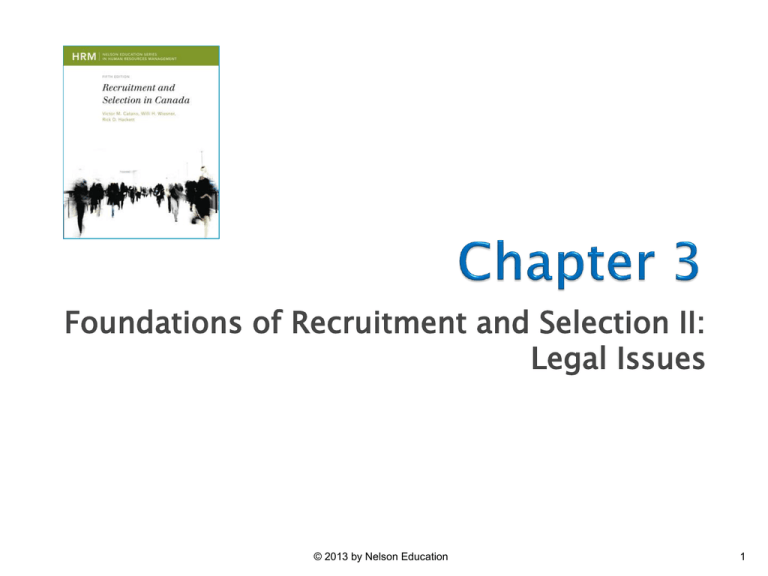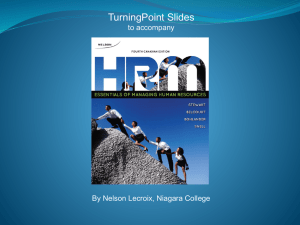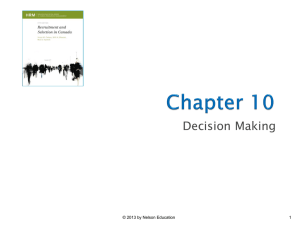
Foundations of Recruitment and Selection II:
Legal Issues
© 2013 by Nelson Education
1
Chapter Learning Outcomes
After reading this chapter you should:
◦ Understand the major legal issues affecting
recruitment and selection
◦ Know how relevant human rights and
employment equity legislation and policies affect
recruitment and selection in your organization
◦ Understand and be able to describe how legal
concerns affect the practice of recruitment and
selection
© 2013 by Nelson Education
2
Chapter Learning Outcomes
◦ Know, and be capable of explaining the key legal
concepts that have had an impact on recruitment
and selection in this country
◦ Be able to apply the basic concepts and principles
discussed in the chapter to the development of
recruitment and selection system that meet legal
requirements
© 2013 by Nelson Education
3
Four Legal Sources Affecting
Canadian Employment Practices
1.
2.
3.
4.
Constitutional law
Human rights legislation
Employment equity
Labour law, employment standards, and
related legislation
© 2013 by Nelson Education
4
Constitutional Law
Constitutional law: the Supreme Law of
Canada
◦ It has a pervasive impact on employment
practices, as it does on all spheres of Canadian
Society
◦ Section 15 of the Canadian Charter of Rights and
Freedoms
© 2013 by Nelson Education
5
Human Rights Law
Human rights legislation: prohibits
discrimination in both employment and the
provision of goods and services (e.g., rental
housing, service-in restaurants)
◦ Legislation generally establishes human rights
commissions or tribunals to deal with complaints,
including those involving employment
discrimination
© 2013 by Nelson Education
6
Human Rights Law
Section 8 of the Canadian Human Rights Act
refers to a “a prohibited ground of
discrimination.”
The following are grounds on which
discrimination is prohibited:
◦ Race, national or ethnic origin, colour, religion,
age, sex (including pregnancy and childbirth),
marital status, family status, mental or physical
disability, pardoned conviction, sexual
orientation
© 2013 by Nelson Education
7
© 2013 by Nelson Education
8
Prohibited Grounds of Employment
Discrimination (continued)
© 2013 by Nelson Education
9
Prohibited Grounds of Employment
Discrimination (continued)
© 2013 by Nelson Education
10
Prohibited Grounds of Employment
Discrimination (continued)
© 2013 by Nelson Education
11
Prohibited Grounds of Employment
Discrimination (continued)
© 2013 by Nelson Education
12
Prohibited Grounds of Employment
Discrimination (continued)
© 2013 by Nelson Education
13
Employment Equity Legislation
Employment equity: the elimination of
discriminatory practices that prevent the
entry or retention of members from
designated groups in the workplace, and
the elimination of unequal treatment in the
workplace related to membership in a
designated group (e.g., women, visible
minorities, Aboriginal peoples, and people
with disabilities)
© 2013 by Nelson Education
14
Developing and Implementing and
Employment Equity (EE) Plan
1.
2.
3.
Obtain support of senior management for
the EE effort
Conduct a survey to determine the present
representation of designated groups in the
organization’s internal work force
Set future representation targets for
designated groups based on availability of
qualified workers in the labour market
© 2013 by Nelson Education
15
Developing and Implementing and
Employment Equity (EE) Plan
(continued)
4.
5.
6.
Remove systemic employment barriers to
increase representation for designated
groups in the internal work force
Monitor the changing composition of the
internal work force over time
Make necessary changes to the EE
intervention to bring designated group
representation up to future targets
© 2013 by Nelson Education
16
Benefits of Implementing
Employment Equity
A work force representative of Canadian
culture and diversity
An increase in global competitiveness and
productivity
High employee morale and decreased
absenteeism
© 2013 by Nelson Education
17
Benefits of Implementing
Employment Equity (continued)
Amicable relationships with customers and
clients
Enhanced corporate reputation
Increased profitability and a better bottom
line
© 2013 by Nelson Education
18
Class Activity
1.
You are the President of your company.
How would you encourage your managers
to promote Employment Equity in their
department?
© 2013 by Nelson Education
19
Labour Law
Federal/Provincial labour laws: stipulate the
rights of the employees to organize trade
unions and to bargain collective agreements
with employers
Collective agreements: set out the
conditions for unionized employees (e.g.,
Promotion, lateral transfer and demotion)
© 2013 by Nelson Education
20
Employment Standards
Employment standards: federal/provincial
laws to regulate minimum age of
employment, hours of work, minimum
wages, statutory holidays, vacations, work
leaves, and termination of employment
© 2013 by Nelson Education
21
Key Legal Concepts in Recruitment
and Selection
Direct discrimination: occurs where an
employer adopts a practice or rule that, on
its face, discriminates on a prohibited
ground
© 2013 by Nelson Education
22
Key Legal Concepts in Recruitment
and Selection (continued)
Indirect discrimination: occurs when an
employer, in good faith, adopts a policy or
practice for sound economic, or business
reasons, but when it is applied to all
employees it has an unintended, negative
impact on members of a protected group
© 2013 by Nelson Education
23
Key Legal Concepts in Recruitment
and Selection (continued)
Protected groups: those who have attributes
that are defined as “prohibited grounds” for
discrimination under the human rights act
that applies to the employing organization
Adverse impact: occurs when the selection
rate for a protected group is lower than that
for the relevant comparison group
© 2013 by Nelson Education
24
Key Legal Concepts in Recruitment
and Selection (continued)
Bona fide occupational requirement (BFOR):
requirement(s) that a person must possess
to perform the essential components of a
job in a safe, efficient, and reliable manner
© 2013 by Nelson Education
25
Key Legal Concepts in Recruitment
and Selection (continued)
Accommodation: the duty of an employer to
put in place modifications to discriminatory
employment practices or procedures to
meet the needs of members of a protected
group being affected by the employment
practice or procedure
© 2013 by Nelson Education
26
Key Legal Concepts in Recruitment
and Selection (continued)
Sufficient risk: an employer may argue that
an occupational requirement that
discriminates against a protected group is
reasonably necessary to ensure that work
will be performed successfully and in a
manner that will not pose harm or danger
to employees or the public
© 2013 by Nelson Education
27
Key Legal Concepts in Recruitment
and Selection (continued)
Undue hardship: the limit beyond which
employers and service providers are not
expected to accommodate a member of a
protected group
© 2013 by Nelson Education
28
Key Legal Concepts in Recruitment
and Selection (continued)
Adverse effect discrimination: a situation
where an employer, in good faith, adopts a
policy or practice that has an unintended,
negative impact on members of a protected
group
© 2013 by Nelson Education
29
Class Activity
1.
2.
What does it mean to accommodate
someone to the point of undue hardship?
When can an apparently discriminatory
selection practice by justified on the
grounds of “sufficient risk”?
© 2013 by Nelson Education
30
Outreach Recruiting
Outreach recruiting: the employing
organization makes a determined and
persistent effort to make potential job
applicants, including designated group
members, aware of available positions
within the employing organizations
© 2013 by Nelson Education
31
Recruitment and Selection
Notebook 3.5
Effective Practices for Nondiscriminatory
Recruiting
◦ Post complete, objective, and specific information
on all available jobs in a conspicuous spot
◦ Advertise job openings in media that are read,
viewed, or listened to by protected or designated
group members
◦ Train employment clerical staff and recruitment
officers in outreach recruiting
© 2013 by Nelson Education
32
Recruitment and Selection
Notebook 3.5 (continued)
◦ Base selection criteria on bona fide occupational
requirements
◦ Use opportunities to visually present protected or
designated group members in positive
employment roles
◦ Establish networks with community groups from
which protected or designated group members
are drawn
◦ Set and advertise objectively determined selection
criteria for the job
© 2013 by Nelson Education
33
Recruitment and Selection
Notebook 3.5 (continued)
Ineffective Practices for Nondiscriminatory
Recruiting
◦ Permit receptionists and recruiters in
employment offices to “pre-screen” applicants on
the basis of informal criteria (e.g., appearance,
dress)
◦ Rely on word-of-mouth advertising
◦ Post job advertisements only in-house
© 2013 by Nelson Education
34
Recruitment and Selection
Notebook 3.5 (continued)
◦ Rely solely on seniority when promoting
employees without regard for meeting the
qualifications need for the position
◦ Allow each recruiter to use and communicate
idiosyncratic criteria for selecting among job
applicants
◦ Categorize and stream job applicants based on
stereotyped assumptions about protected or
designated group membership (e.g., that women
are not physically strong enough for certain work)
© 2013 by Nelson Education
35
Summary
The work force is becoming increasingly
diverse with regard to race, gender, and
disabilities
Diversity, human rights, and employment
equity are important
© 2013 by Nelson Education
36
Summary (continued)
There are four main legal sources:
constitutional law, human rights legislation,
employment equity, and labour law and
employment standards
Labour codes and related legislation will
affect recruitment and selection practices in
Canadian organizations
© 2013 by Nelson Education
37
Discussion Questions
1.
2.
What are the prohibited grounds of
employment discrimination in Ontario?
Why is basing hiring practices on a “gut
feeling” risky business?
© 2013 by Nelson Education
38










